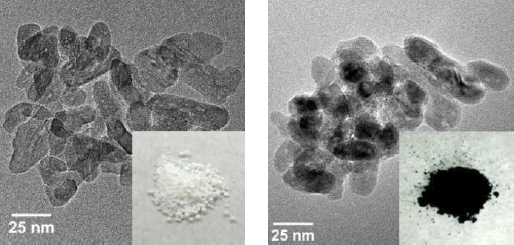Novel Synthesis Process for Nanosized Reduced Titanium Oxide
The High Quality Nanoparticles Having High Functions Make a Significant Step Toward the Development of Artificial Photosynthesis and Alternative Materials to Precious Metals
2011.07.06
(2011.07.20 Update)
National Institute for Materials Science
The NIMS International Center for Materials Nanoarchitectonics (MANA) succeeded for the first time in the world in synthesizing a titanium oxide material in which the interior is transformed to a reduced type oxide having a different crystal structure while retaining the original nanostructure of TiO2.
Abstract
- Dr. Satoshi Tominaka, a MANA Scientist, and Dr. Yoshihiro Tsujimoto, a MANA Researcher, both at the International Center for Materials Nanoarchitectonics (Director-General: Masakazu Aono), National Institute for Materials Science (President: Sukekatsu Ushioda), succeeded for the first time in the world in synthesizing a titanium oxide material in which the interior is transformed to a reduced type oxide (Ti2O3) with a different crystal structure while retaining the original nanostructure of the titanium dioxide (TiO2).
- Because reduced titanium oxide is known to have attractive properties such as electrical conductivity and visible light absorption, use in a wide range of applications, including solar cells and fuel cells, is expected if a nanostructured morphology can be obtained. However, in the conventional synthesis process, heating to high temperature was necessary, making it difficult to synthesize nanostructured materials.
- Using rutile-type TiO2 nanoparticles as the starting material, the team led by Dr. Tominaka discovered a reduction technique in which the material is transformed to a reduced titanium oxide while maintaining the original morphology and size of the starting material by reaction at a temperature of 350°C, which is dramatically lower than the conventional reduction temperature of 800-1100°C. This is achieved by mixing the starting material with calcium hydrate powder, which has strong reducing power even at low temperature.
- This result provides a new technique for producing a nano oxide with high functionality and homogeneity, and is an innovative achievement with the potential for development to material synthesis in a wide range of fields such as fuel cells, solar cells, etc. This research was carried out jointly by MANA and the NIMS Beamline (BL15XU) at the SPring-8 Large-Scale Synchrotron Radiation Facility. This result will be published in Angewante Chemie International Edition, which is the international journal of the German Chemical Society.

Figure: Transmission electron microscope images and photographs of titanium oxide nanoparticles. (Left) Nanoparticles of TiO2, which appear white because they do not absorb visible light. (Right) Nanoparticles of the reduced type titanium oxide synthesized in this research. Because the material absorbs visible light, the nanoparticles appear black.